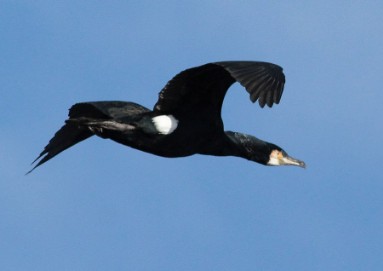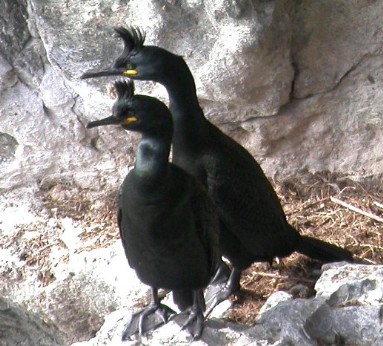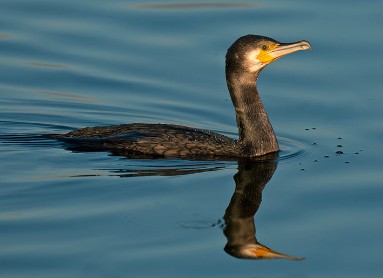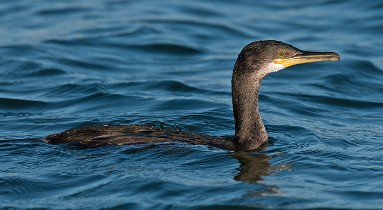Identifying Cormorants and Shags


In February 2008 I wrote a short article for the “Arran Banner” on these closely related species. From various recent contacts with readers I felt a need to revisit this subject with the intention of trying to help with the identification of these easily confused species.
Both Cormorants and Shags are common round the coast of Arran throughout the year, but on Arran the Shag is much more numerous than the Cormorant. Both have breeding colonies on Pladda. Both are black, fish eating birds that sit low in the water with heads up-tilted. Both dive from the surface of the water with a quick arching forward leap that takes them clear of the surface of the water. After fishing, both Cormorant and Shag can be seen standing upright on a rock with their wings held out to dry. In other words, both in looks and behaviour, they are very similar.
In breeding plumage they are relatively easy to tell apart. The Cormorant has a diagnostic white thigh patch. The Shag has a recurved short wispy crest and dark thighs. At other times, it is the difference in size and shape that you have to rely on to help tell them apart.
Cormorants are altogether bigger. Cormorants have a bigger, more triangular head, a flatter forehead and more massive bill, giving an angular almost wedge shaped look to the head. There is a white gular (throat) patch and the green eye is set within bare skin.
Shags are significantly smaller, shorter and more slender. Shags have a small head with a peaked forehead and slimmer bill. There is no gular patch but there is a yellow gape and the green eye is set within feathers.
In flight, Shags have a shorter, thinner and much straighter neck and thinner bill, as well as shorter, more rounded wings, leading to quicker wing-beats. Its more rounded, pot belly is apparent and the wing bases appear to be set more to the rear of the bird, unlike Cormorant’s more central position.
While juvenile Cormorants have pale almost white under-parts, juvenile Shags have a uniform brown tint to chest and belly, with only the undertail coverts being white.
Next time you are on the coast have a look at these big black birds, get familiar with their features and confidently say whether it is a Shag or a Cormorant.
For further help in identifying these species check out this video link. Identifying Cormorant and Shag | BTO - British Trust for Ornithology https://www.bto.org/about-birds/bird-id/bto-bird-id-cormorant-and-shag
This is part of the excellent series of bird identification videos produced by the British Trust for Ornithology https://www.bto.org/about-birds/bird-id

